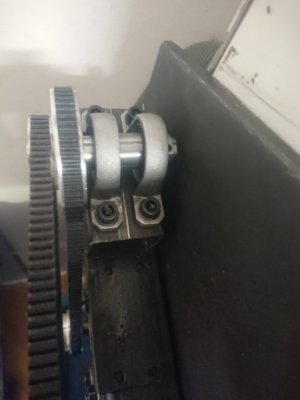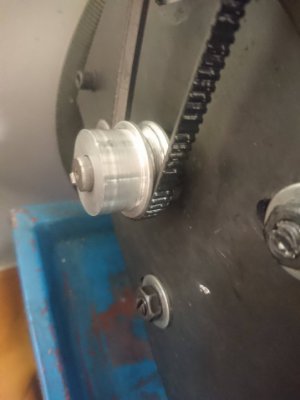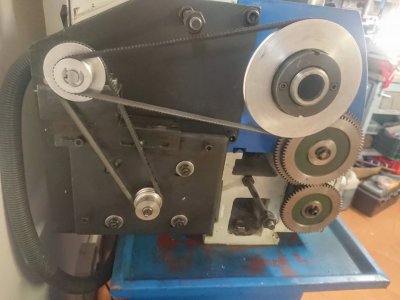I find the lack of torque at low speed to be too much of a problem, it prevents or makes very difficult to do some work that would be straightforward on a 'real' lathe, even a small one. So I went to do something about it. This is a quick summary of how I did it, there is no BOM, drawings or instructions, but if anyone could use more details or explanations please ask. Also, I know well that some details are not as good as they should, as in the C-clip on the pulley shaft, or the long slots on the bracket; right now I just wanted to share my work and will return to these later.
The lathe
My lathe is a 'standard' 250mm x 550mm China made, which you can find under a wide variety of names. The motor is 220VDC, advertised as being 750W, there are two-stepped pulleys with the low speed shown as 50-1250rpm on the cover. Even the manual says in practice, use that only. In reality it is not usable (except for very very light work) below 250rpm.
Possible solutions
First, I researched about a new AC single phase motor with slow speed specifications. After navigating all the variations of the Chinese '110ZYT' denomination, and talking to a patient Chinese seller, I gave up on that. There is no guarantee that it would perform any better than the original one, and it wouldn't have been a cheap experiment either.
Then I found that there are now kits available with inverter/controller board and three-phase motor, going from 550 to 1100W, https://www.aliexpress.com/item/-/4001122570610.html
This is evidently what is now used on the better models, has the advantage of fitting right in the available motor space, mounting flange and belt pulley, with not so much work . These are quite expensive, too. Then, my reasoning was that even with a big torque, I would have likely found another weak point, be that in power transmission via a small V-belt, or top slide rigidity, etc. In the end there is only so much you can expect from something having a 135mm wide bed. Instead, I would have been happy with a compromise solution, which would keep things in balance, not too complicated or costly. That also excluded funky setups with externally mounted three-phase motors, related fabrications, inverters/VFD and the like.
Pulley reducer
I concluded that gearing down spindle speed would have been enough. The motor mount has a 40mm wide shoulder that looks made to hold pillow blocks bearings. That was done with standard L stock. The new reducing pulleys compound is 33.5 to 58mm for a total reduction of 6.5 : 1, much better than the original of 3.75 : 1. I turned three 60deg sheaves, the first ones that I have ever made. The keyways were cut on the lathe with the carriage, ground the necessary cutters, etc. The shaft is 12mm SS stock, milled for keyway and flats. There is a bushing in between the bearings, that is important as it helps keeping the shaft square to the blocks, which are not designed to be so close when there is a significant radial force as in this case.

The pulley on the motor had to be made anew because even if the original one can be reversed to match on the reducer, it can't go in enough and doesn't align.

Positioning
At first, I tried to place the pulley almost in between motor and spindle. The spindle belt is tensioned pushing the L bracket to the left, it has milled slots that reuse the fasteners, then the motor belt is tensioned sliding the motor down as in the original system. Consequently, I calculated and bought two new belts. That didn't worked, because the distance between the 34mm pulley and the spindle 126mm one is too short, there is not enough belt contact to the small one - lesson learned.
So I figured that since the original belt works, that is what I had to use. That caused the pulley to be moved all the way outward to the left, and introduced a square 40mm tubing welded on the bracket, and bolted to the bearing blocks. Inconveniently, the motor pulley goes exactly above a fastener for the motor, and one for the mount; that is not a big deal actually and one can keep both of them in place. Fortunately I was able to reuse the longest of the two belts I had bought already, the quadrant cover fits, and all seems to be working good.

First impressions
Very happy with the result so far. Three off the shelf parts for a total of $20 made a big difference. First I tried was parting off some 14mm steel stock. Even with a perfect blade, holder and lubrication, that was not a quick job before the modification. Above 40mm stock it was just aggravating, the motor would stall, or the belt slip. This time it went through at 200rpm without any issue. I will update this thread as soon I will try some serious screw cutting. Thank you for reading.
The lathe
My lathe is a 'standard' 250mm x 550mm China made, which you can find under a wide variety of names. The motor is 220VDC, advertised as being 750W, there are two-stepped pulleys with the low speed shown as 50-1250rpm on the cover. Even the manual says in practice, use that only. In reality it is not usable (except for very very light work) below 250rpm.
Possible solutions
First, I researched about a new AC single phase motor with slow speed specifications. After navigating all the variations of the Chinese '110ZYT' denomination, and talking to a patient Chinese seller, I gave up on that. There is no guarantee that it would perform any better than the original one, and it wouldn't have been a cheap experiment either.
Then I found that there are now kits available with inverter/controller board and three-phase motor, going from 550 to 1100W, https://www.aliexpress.com/item/-/4001122570610.html
This is evidently what is now used on the better models, has the advantage of fitting right in the available motor space, mounting flange and belt pulley, with not so much work . These are quite expensive, too. Then, my reasoning was that even with a big torque, I would have likely found another weak point, be that in power transmission via a small V-belt, or top slide rigidity, etc. In the end there is only so much you can expect from something having a 135mm wide bed. Instead, I would have been happy with a compromise solution, which would keep things in balance, not too complicated or costly. That also excluded funky setups with externally mounted three-phase motors, related fabrications, inverters/VFD and the like.
Pulley reducer
I concluded that gearing down spindle speed would have been enough. The motor mount has a 40mm wide shoulder that looks made to hold pillow blocks bearings. That was done with standard L stock. The new reducing pulleys compound is 33.5 to 58mm for a total reduction of 6.5 : 1, much better than the original of 3.75 : 1. I turned three 60deg sheaves, the first ones that I have ever made. The keyways were cut on the lathe with the carriage, ground the necessary cutters, etc. The shaft is 12mm SS stock, milled for keyway and flats. There is a bushing in between the bearings, that is important as it helps keeping the shaft square to the blocks, which are not designed to be so close when there is a significant radial force as in this case.

The pulley on the motor had to be made anew because even if the original one can be reversed to match on the reducer, it can't go in enough and doesn't align.

Positioning
At first, I tried to place the pulley almost in between motor and spindle. The spindle belt is tensioned pushing the L bracket to the left, it has milled slots that reuse the fasteners, then the motor belt is tensioned sliding the motor down as in the original system. Consequently, I calculated and bought two new belts. That didn't worked, because the distance between the 34mm pulley and the spindle 126mm one is too short, there is not enough belt contact to the small one - lesson learned.
So I figured that since the original belt works, that is what I had to use. That caused the pulley to be moved all the way outward to the left, and introduced a square 40mm tubing welded on the bracket, and bolted to the bearing blocks. Inconveniently, the motor pulley goes exactly above a fastener for the motor, and one for the mount; that is not a big deal actually and one can keep both of them in place. Fortunately I was able to reuse the longest of the two belts I had bought already, the quadrant cover fits, and all seems to be working good.

First impressions
Very happy with the result so far. Three off the shelf parts for a total of $20 made a big difference. First I tried was parting off some 14mm steel stock. Even with a perfect blade, holder and lubrication, that was not a quick job before the modification. Above 40mm stock it was just aggravating, the motor would stall, or the belt slip. This time it went through at 200rpm without any issue. I will update this thread as soon I will try some serious screw cutting. Thank you for reading.
Last edited:

